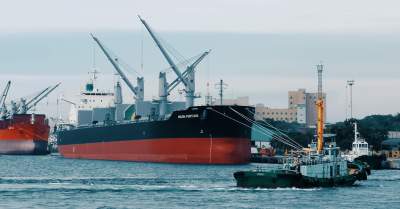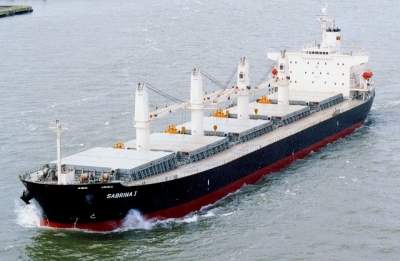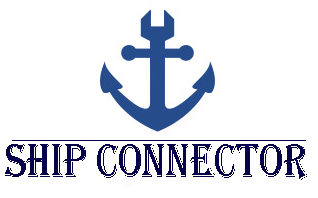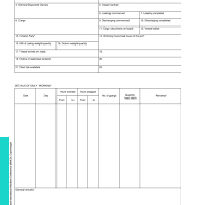What are Bulk Carrier ships?
Contents
Bulk carrier ships
The ship designed to carrier bulk cargoes are called as Bulk carrier, the cargo is loaded in the loose form as per the stowage factor of bulk cargo.
The Bulk carrier generally carries bulk cargo like food grains (Rice, wheat, corn, soya-bean etc), ores, coal, cement and Steel products in bulk form.
Bulker carrier may also carry liquefied cargoes in bulk form. The liquefied cargo such as oil, petrol and various other liquid chemical substances is carried by bulk carriers.
Presently, the market share of bulk carriers makes up around 21% of the world merchant fleet.
Over 50% of all Bulk carriers are owned by Greece, Japan and China, 25% of bulk carrier are registered in Panama.

Size range of Bulk carrier
The size range of bulk carrier are from Mini-bulk carriers with single hold to mammoth ore ships which are able to carry 400,000 MT of DWT.
Geared Bulk carrier

The Geared bulk carrier have cranes installed on them and can load/ unload their own cargo themselves
Gearless Bulk carrier
The Gearless bulk cargo do not have cranes installed on them and they have to depend on shore facility for loading/discharging.
Bulk carrier Owners
Greece, Japan, China, Panama. South Korea are some of the leading bulk carrier owning nations.
Crew role in Bulk carrier
The crew on board takes care of everyday operation, management, and maintenance of the vessel, the officers and crew always works with safety and gives due regards to the ship and cargo safety.
Crew size in Bulk carrier
Crew can range in size from 3 to 30, from smallest to the largest.
Types of Bulk Carrier
Conventional bulkers
Conventional bulker are designed to carry bulk and multi-purpose cargo and can sail on any given sea routes, these bulker depending on their size has 5-9 holds with hold covers (hatch).
The above type of bulker remains in demand forever.
Cranes with grabs are installed on this type of bulkers and cargo can be loaded or discharge using these cranes, cranes can run for long time without rest.
The cranes gives them more weightage as loading and discharging can happen in those ports where there are no cranes available on shore.
These vessels were the first type of bulk carrier to be added in the modern type of fleet.
Gearless Bulk carriers
Bulkers that have no cranes and conveyor facilities installed on them are called gearless bulkers.
Gearless Bulk carrier are Huge in size, but without the cranes installed on them.
This makes them cost effective as the cost of installation of cranes is reduced.
Generally conveyor facility is provided on such type of vessel for loading and discharging purpose, these bulk carriers due to their size and draught restrictions make port call to those ports which provide conveyor and crane facilities.
Due to the restrictions we can see very less number of ports for Gearless type of bulkers.
Gearless bulk carriers are unable to carry out operations were shore assistance is not provided.
Gearless bulkers are huge in size and can only go alongside the big ports.
Self Dischargers
Self-discharging bulkers as the name suggest is equipped with Self-discharging and Loading facilities,Conveyor belts or Cranes -grabs are used to load or discharge cargo.
Self-discharging bulkers operates in any inaccessible waterway as they do not require any shore-based system to carry out operations.
These vessel can discharge directly on the quay, barge or hoppers.
The cranes and hoppers are hydraulically operated.
Bulker lakers
Bulker lakers are bulk carrier which can transit and ply in the American great lakes,they have different construction style,these vessels enjoy better operational longevity.
BIBO or Bulk –in Bags Out
Cargo is loaded in bulk but comes out packed in bags as the vessel is equipped with baggage equipment system, bags are discharged instead of bulk cargo.
OBO Carrier/Combined bulk carrier
This type of vessel is designed to carry combination of ore, bulk, and oil.
Open hatch bulk carrier
These are the bulk carrier which have open hatch or they do not have covers on holds, the cargo is loaded and discharged directly.
Gantry cranes are installed on them for loading/discharging.
Liquid bulk cargo
Tankers are responsible to carries liquid cargoes in bulk.
As in dry bulk cargo carrier,cargo is loaded inside the holds ,in tankers, oil is loaded in separate tanks with the help of pipelines system.
Ballast tanks are provided separately for stability purpose
Inert gas system is fixed on tankers to reduce the risk of fire and explosion.
Crude Carriers
The crude carrier are very large in size and carries crude oil to the refineries of different nations, later refineries process crude oil to diesel ,petrol and different products.
Very Large Crude Carriers (VLCCs) and the Ultra Large Crude Carriers (ULCCs) are the largest ship in the category.
Due to the giant size of the crude carriers they mostly load or discharge at offshore buoys and terminals.
Product Carriers:
Product carrier are smaller than crude carriers and transports the refined products, Products like petroleum, jet fuel, diesel, asphalt, lubricating oil and tar, from larger terminals to smaller ports worldwide.
Non-petroleum bulk liquids such as molasses and palm oil are transported by small tanker.
Chemical Carriers:
A Chemical carrier has a dwt( deadweight) of 5,000-40,000 tons
Chemical carrier are smaller than other tanker due to the specialized cargo they have to transport and the other reason is restrictions in size of the port terminals for loading and discharging cargo.
The cargo tanks of these type of tanker are either coated with phenolic epoxy / zinc paint or made from stainless steel.
This helps in determines types of cargo to be loaded on particular tank stainless steel tanks can load sulfuric and phosphoric acid, epoxy coated tanks can load vegetable oil.
Heating / cooling apparatus and advanced cleaning systems is used to ensure that the cargo loaded is pure and not mixed with previous loaded cargo.
Liquefied Gas Carriers:
Liquefied Gas carrier carry Liquefied Petroleum Gas (LPG) or Liquefied Natural Gas (LNG) , the cargo is loaded under pressure, and cargo tanks are designed spherical in shape to provide strength.
Liquefied Petroleum Gas (LPG) Carriers-
It carries anhydrous ammonia, butane, propane, butadiene, propylene, vinyl chloride monomer (VCM).
Liquefied Natural Gas (LNG) Carriers-
It carries liquefied natural gas eg.methane.
LPG are smaller then LNG carrier, ‘Q-Flex’ vessels are the largest LNG with a capacity of up to266,000 cbm.
Other type of Bulk carrier
Kamsarmax
Seawaymax,
Setouchmax,
Dunkirkmax, and
Newcastlemax
Valemax
“Valemax”
The Valemax are the ships engage in transportation of Iron ore and they have Dead-weight of 400,000 tons and length of 361m , beam of 65 meters.
“Kamsarmax” :
The Maximum length of Kamsarmax is 229 meters and it is larger than panamax, the name Kamsarmax is given as it can easly accommodate at the Port of Kamsar (Republic of Guinea).
Port of Kamsar- This port is known for major loading terminal of bauxite,the port has restriction imposed to vessels of length not more than 229 meters.
“Newcastlemax” :
The Maximum length of Newcastlemax is 300 meters and beam is 50 meters, Newcastlemax is the type of largest vessel which is able to enter the port of Newcastle, Australia and is about 185,000 DWT.
“Setouchmax” :
The deadweight of Setouchmax is 203,000, Setouchmax is the largest vessels which is able to navigate in Setouchi Sea, Japan.
“Seawaymax” :
Seawaymax has a Length of 226 m max and a draught of 7.92 m. It is the largest vessel that can pass through locks the locks of the St. Lawrence Seaway canal(Great Lakes, Canada).
“Malaccamax” :
Malaccamax has a Length of 330 meters and draught of 20 metres and Deadweight of 300,000 tons, malaccamax is the largest vessel that can pass through the Straits of Malacca.
“Dunkirkmax” :
Dunkirkmax has a Dead-weight of 182,000 tons and length of 292m ,beam of 45m x depth approx. 24.5m for harbour lock in the Port of Dunkirk (France).
Related Read : What is Container Ship
Related Read : Types of ships



